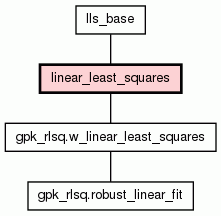__init__(self,
a,
y=None,
minsv=None,
minsvr=None,
copy=True)
(Constructor)
| source code
|
This solves the set of linear equations a*x = y, and allows you to get
properties of the fit via methods. Normally, a.shape==(m,n) and
y.shape==(m,q), and the returned x.shape==(n,q). where m is the number of
constraints provided by the data, n is the number of parameters to use in
a fit (equivalently, the number of basis functions), and q is the number
of separate sets of equations that you are fitting. Then,
self.x() has shape (n,q) and self.the_fit() has
shape (m,q). Interpreting this as a linear regression, there are n
parameters in the model, and m measurements. Q is the number of times you
apply the model to a different data set; each on yields a different
solution.
The procedure uses a singular value decomposition algorithm, and
treats all singular values that are smaller than minsv as zero (i.e.
drops them). If minsvr is specified, it treates all singular values that
are smaller than minsvr times the largest s.v. as zero. The returned rank
is the rank of the solution, which is normally the number of nonzero
elements in x. Note that the shape of the solution vector or matrix is
defined by a and y, and the rank can be smaller than m.
- Overrides:
object.__init__
Note:
Y may be a 1-D matrix (a vector), in which case the fit is a
vector. This is the normal case where you are fitting one
equation. If y is a 2-D matrix, each column (second index) in y is
a separate fit, and each column in the solution is a separate
result.
|

